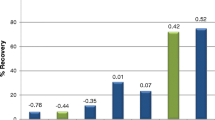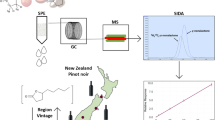Abstract
Native concentrations of α-ionone, β-ionone, and β-damascenone were studied in various authentic and commercial wines. In addition, the enantiomeric distribution of α-ionone was determined and its merits as a potential marker for aroma adulteration in wine were discussed. For extraction of volatiles, headspace solid-phase microextraction (HS-SPME) was applied, followed by heart-cut multidimensional gas chromatography coupled to tandem mass spectrometric detection for trace-level analysis. The enantioselective analysis of α-ionone was achieved with octakis(2,3-di-O-pentyl-6-O-methyl)-γ-cyclodextrin as the chiral selector in the separation column for gas chromatography (GC). In all the authentic wines studied, α-ionone showed a high enantiomeric ratio in favor of the (R)-enantiomer. Since an illegal addition of α-ionone in a racemic form changes the enantiomeric ratio, this ratio may serve as an adulteration marker. Concentrations varied between <LOD to 0.081 μg/L for α-ionone, <LOD to 1.0 μg/L for β-ionone, and 0.03–10.3 μg/L for β-damascenone. Commercial wines of suspiciously strong flavor yielded concentrations up to 4.6 μg/L for α-ionone, 3.6 μg/L for β-ionone, and 4.3 μg/L for β-damascenone. Elevated α- and β-ionone concentrations serve as additional indicators for a potential adulteration. In order to classify the concentrations of the analytes in the context of their odor activity in wine, odor thresholds were determined.

Trace-level analysis of authenticity markers in wine







Similar content being viewed by others
References
Mendes-Pinto MM. Carotenoid breakdown products the-norisoprenoids-in wine aroma. Arch Biochem Biophys. 2009;483(2):236–45.
Armada L, Fernandez E, Falque E. Influence of several enzymatic treatments on aromatic composition of white wines. LWT-Food Sci Technol. 2010;43(10):1517–25. doi:10.1016/j.lwt.2010.06.009.
Aznar M, Lopez R, Cacho J, Ferreira V. Prediction of aged red wine aroma properties from aroma chemical composition. Partial least squares regression models. J Agric Food Chem. 2003;51(9):2700–7. doi:10.1021/jf026115z.
Genovese A, Dimaggio R, Lisanti MT, Piombino P, Moio L. Aroma composition of red wines by different extraction methods and gas chromatography-sim/mass spectrometry analysis. Ann Chim. 2005;95(6):383–94. doi:10.1002/adic.200590045.
Hernandez-Orte P, Lapena AC, Escudero A, Astrain J, Baron C, Pardo I, et al. Effect of micro-oxygenation on the evolution of aromatic compounds in wines: malolactic fermentation and ageing in wood. LWT-Food Sci Technol. 2009;42(1):391–401. doi:10.1016/j.lwt.2008.05.020.
Pineau B, Barbe J-C, Van Leeuwen C, Dubourdieu D. Which impact for β-damascenone on red wines aroma? J Agric Food Chem. 2007;55(10):4103–8.
Silva Ferreira AC, Guedes de Pinho P. Nor-isoprenoids profile during port wine ageing—influence of some technological parameters. Anal Chim Acta. 2004;513(1):169–76.
Z-m X, Y-s T, Zhang L, Li H. Impact of cover crops in vineyard on the aroma compounds of Vitis vinifera L. cv Cabernet Sauvignon wine. Food Chem. 2011;127(2):516–22. doi:10.1016/j.foodchem.2011.01.033.
Zhang L, Tao YS, Wen Y, Wang H. Aroma evaluation of young Chinese Merlot wines with denomination of origin. S Afr J Enol Vitic. 2013;34(1):46–53.
Zamuz S, Vilanova M. Volatile compounds after spontaneous fermentation of musts from Vitis vinifera cv. Albarino grapes cultivated in different origins from Rias Baixas AOC, Spain. Flavour Fragrance J. 2006;21(5):743–8. doi:10.1002/ffj.1744.
Dieguez SC, Lois LC, Gomez EF, de la Pena MLG. Aromatic composition of the Vitis vinifera grape Albarino. Lebensm-Wiss Technol. 2003;36(6):585–90. doi:10.1016/s0023-6438(03)00064-1.
Ferreira V, Lopez R, Cacho JF. Quantitative determination of the odorants of young red wines from different grape varieties. J Sci Food Agric. 2000;80(11):1659–67. doi:10.1002/1097-0010(20000901)80:11<1659::aid-jsfa693>3.0.co;2-6.
Etievant PX. Wine. In: Volatile compounds in foods and beverages. Maarse H (ed.), New York, Basel: Marcel Dekker, Inc.; 1991. p. 483-546.
Meilgaard M, Elizondo A, Moya E. A study of carbonyl compounds in beer, part II. Flavour and flavour thresholds of aldehydes and ketones added to beer. Tech Q MBAA Commun. 1970;7(3):143–9.
Meilgaard M, Moya E. A study of carbonyl compounds in beer—1. Background and literature review. Tech Q MBAA Commun. 1970;7(3):135–42.
Guth H. Quantitation and sensory studies of character impact odorants of different white wine varieties. J Agric Food Chem. 1997;45(8):3027–32. doi:10.1021/jf970280a.
Frank S, Wollmann N, Schieberle P, Hofmann T. Reconstitution of the flavor signature of Dornfelder red wine on the basis of the natural concentrations of its key aroma and taste compounds. J Agric Food Chem. 2011;59(16):8866–74. doi:10.1021/jf202169h.
Kotseridis Y, Baumes R, Skouroumounis GK. Synthesis of labeled [2H4]β-damascenone, [2H2]2-methoxy-3-isobutylpyrazine, [2H3]α-ionone, and [2H3]β-ionone, for quantification in grapes, juices and wines. J Chromatogr A. 1998;824(1):71–8. doi:10.1016/s0021-9673(98)00650-5.
Aprea E, Biasioli F, Gasperi F. Volatile compounds of raspberry fruit: from analytical methods to biological role and sensory impact. Molecules. 2015;20(2):2445–74. doi:10.3390/molecules20022445.
Pyysalo T. Identification of volatile compounds in hybrids between raspberry (Rubus idaeus, L.) and arctic bramble (Rubus arcticus, L.). Z Lebensm-Unters Forsch. 1976;162(3):263–72. doi:10.1007/bf01113308.
Regulation (EC) No. 606/2009 of July 2009 laying down certain detailed rules for implementing Council Regulation (EC) No 479/2008 as regards the categories of grapevine products, oenological practices and the applicable restrictions. Official Journal of the European Union. 2009; L193:1-59.
Mosandl A. Enantioselective capillary gas chromatography and stable isotope ratio mass spectrometry in the authenticity control of flavors and essential oils. Food Rev Int. 1995;11(4):597–664.
Mosandl A, Braunsdorf R, Dietrich A, Faber B, Karl V, Koepke T, et al. Recent developments in the authenticity control of flavors and fragrances. Dev Food Sci. 1994;35:89–98.
Werkhoff P, Bretschneider W, Guentert M, Hopp R, Surburg H. Chirospecific analysis in flavor and essential oil chemistry. Part 2. Direct enantiomer resolution of trans-α-ionone and trans-α-damascone by inclusion gas chromatography. Z Lebensm-Unters Forsch. 1991;192(2):111–5. doi:10.1007/bf01202622.
Casabianca H, Graff JB. Enantiomeric and isotopic analysis of flavor compounds of some raspberry cultivars. J Chromatogr A. 1994;684(2):360–5. doi:10.1016/0021-9673(94)00618-0.
Sewenig S, Bullinger D, Hener U, Mosandl A. Comprehensive authentication of (E)-α(β)-ionone from raspberries, using constant flow MDGC-C/P-IRMS and enantio-MDGC-MS. J Agric Food Chem. 2005;53(4):838–44. doi:10.1021/jf040356k.
Vrhovsek U, Lotti C, Masuero D, Carlin S, Weingart G, Mattivi F. Quantitative metabolic profiling of grape, apple and raspberry volatile compounds (VOCs) using a GC/MS/MS method. J Chromatogr B. 2014;966:132–9. doi:10.1016/j.jchromb.2014.01.009.
Schmarr H-G, Mosandl A, Kaunzinger A. Influence of derivatization on the chiral selectivity of cyclodextrins: alkylated/acylated cyclodextrins and γ-/δ-lactones as an example. J Microcolumn Sep. 1991;3(5):395–402. doi:10.1002/mcs.1220030503.
Sen A, Laskawy G, Schieberle P, Grosch W. Quantitative determination of β-damascenone in foods using a stable isotope dilution assay. J Agric Food Chem. 1991;39(4):757–9. doi:10.1021/jf00004a028.
Legrum C, Slabizki P, Schmarr H-G. Enantiodifferentiation of 3-sec-butyl-2-methoxypyrazine in different species using multidimensional and comprehensive two-dimensional gas chromatographic approaches. Anal Bioanal Chem. 2015;407(1):253–63. doi:10.1007/s00216-014-8061-8.
Slabizki P, Fischer C, Legrum C, Schmarr H-G. Characterization of atypical off-flavor compounds in natural cork stoppers by multidimensional gas chromatographic techniques. J Agric Food Chem. 2015;63(35):7840–8. doi:10.1021/acs.jafc.5b02793.
Schmarr H-G, Slabizki P, Legrum C. Optimization in multidimensional gas chromatography applying quantitative analysis via a stable isotope dilution assay. Anal Bioanal Chem. 2013;405(20):6589–93. doi:10.1007/s00216-013-7072-1.
Designation ASTM E 1432-04. Standard practice for defining and calculating individual and group sensory thresholds from forced-choice data sets of intermediate size. ASTM (2007). http://www.astm.org/Standards/E1432.htm
UNE-ISO 13301. Sensory analysis—methodology—general guidance for measuring odour, flavour and taste detection thresholds by a three-alternative forced-choice (3-AFC) procedure, 2002.
Kreck M, Scharrer A, Bilke S, Mosandl A. Stir bar sorptive extraction (SBSE)-enantio-MDGC-MS—a rapid method for the enantioselective analysis of chiral flavour compounds in strawberries. Eur Food Res Technol. 2001;213(4-5):389–94. doi:10.1007/s002170100397.
König WA, Evers P, Krebber R, Schulz S, Fehr C, Ohloff G. Determination of the absolute configuration of α-damascone and α-ionone from black tea by enantioselective capillary gas chromatography. Tetrahedron. 1989;45(22):7003–6. doi:10.1016/s0040-4020(01)89167-5.
König WA, Evers P, Krebber R, Schulz S, Fehr C, Ohloff G. Determination of the absolute configuration of α-damascone and α-ionone from black tea by enantioselective capillary gas chromatography. [Erratum to document cited in CA113(3):24261p]. Tetrahedron. 1992;48(10):1741.
Blank I, Milo C, Lin J, Fay LB. In: Flavor chemistry: thirty years of progress, Teranishi R, Wick EL, Hornstein I (eds.). Quantification of aroma-impact components by isotope dilution assay-recent developments. Kluwer Academic Plenum Publishers, New York, 1999:63-74
Schmarr H-G, Slabizki P, Legrum C, Langen J. Wenn Nanogramm das Aroma verändern. Nachr Chem. 2014;62(12):1192–6. doi:10.1002/nadc.201490423.
Caven-Quantrill DJ, Buglass AJ. Comparison of volatile constituents extracted from model grape juice and model wine by stir bar sorptive extraction-gas chromatography-mass spectrometry. J Chromatogr A. 2011;1218(7):875–81. doi:10.1016/j.chroma.2010.12.078.
Vilanova M, Zamuz S, Vilarino F, Sieiro C. Effect of terroir on the volatiles of Vitis vinifera cv. Albarino J Sci Food Agric. 2007;87(7):1252–6. doi:10.1002/jsfa.2833.
McRae JF, Jaeger SR, Bava CM, Beresford MK, Hunter D, Jia Y, et al. Identification of regions associated with variation in sensitivity to food-related odors in the human genome. Curr Biol. 2013;23(16):1596–600. doi:10.1016/j.cub.2013.07.031.
Amoore JE. Specific anosmia: a clue to the olfactory code. Nature. 1967;214(5093):1095–8.
Tsachaki M, Linforth RST, Taylor AJ. Dynamic headspace analysis of the release of volatile organic compounds from ethanolic systems by direct APCI-MS. J Agric Food Chem. 2005;53(21):8328–33. doi:10.1021/jf051202n.
Spaniolas S, Tsachaki M, Bennett MJ, Tucker GA. Toward the authentication of wines of nemea denomination of origin through cleaved amplified polymorphic sequence (CAPS)-based assay. J Agric Food Chem. 2008;56(17):7667–71. doi:10.1021/jf801036f.
Larsen M, Poll L. Odour thresholds of some important aroma compounds in raspberries. Z Lebensm-Unters Forsch. 1990;191(2):129–31. doi:10.1007/BF01202638.
Vilanova M, Martinez C. First study of determination of aromatic compounds of red wine from Vitis vinifera cv. Castanal grown in Galicia (NW Spain). Eur Food Res Technol. 2007;224(4):431–6. doi:10.1007/s00217-006-0322-0.
Acknowledgments
The authors thank the institutions for the donation of reference wine samples (Staatsweingut mit Johannitergut, Neustadt an der Weinstraße, Germany; Höhere Bundeslehranstalt für Wein- und Obstbau Klosterneuburg, Klosterneuburg, Austria; and the Staatliche Lehr- und Versuchsanstalt für Wein- und Obstbau Weinsberg, Weinsberg, Germany). Furthermore, we are thankful for the wine samples from food and wine control authorities in the Rheinland-Pfalz state, Germany. We are particularly grateful to Sandra Klink (DLR Rheinpfalz, Germany) and her team for the sensory analysis and Ulrich Fischer for the fruitful comments and discussions on the manuscript. We also appreciate the support from Carien Coetzee (Stellenbosch University, South Africa) in the early method development stages. Financial support from the Ministerium für Umwelt, Landwirtschaft, Ernährung, Weinbau und Forsten (Rheinland-Pfalz, Germany) is also gratefully acknowledged. We are also indebted to Engela Kritzinger (DLR Rheinpfalz) for language editing.
Author information
Authors and Affiliations
Corresponding author
Ethics declarations
The authors declare their compliance to ethical standards.
Conflict of interest
The authors declare that they have no conflict of interest.
Additional information
This paper is dedicated to Prof. Dr. Peter Schieberle (Freising, Germany) on the occasion of his 65th birthday.
Rights and permissions
About this article
Cite this article
Langen, J., Wegmann-Herr, P. & Schmarr, HG. Quantitative determination of α-ionone, β-ionone, and β-damascenone and enantiodifferentiation of α-ionone in wine for authenticity control using multidimensional gas chromatography with tandem mass spectrometric detection. Anal Bioanal Chem 408, 6483–6496 (2016). https://doi.org/10.1007/s00216-016-9767-6
Received:
Revised:
Accepted:
Published:
Issue Date:
DOI: https://doi.org/10.1007/s00216-016-9767-6




